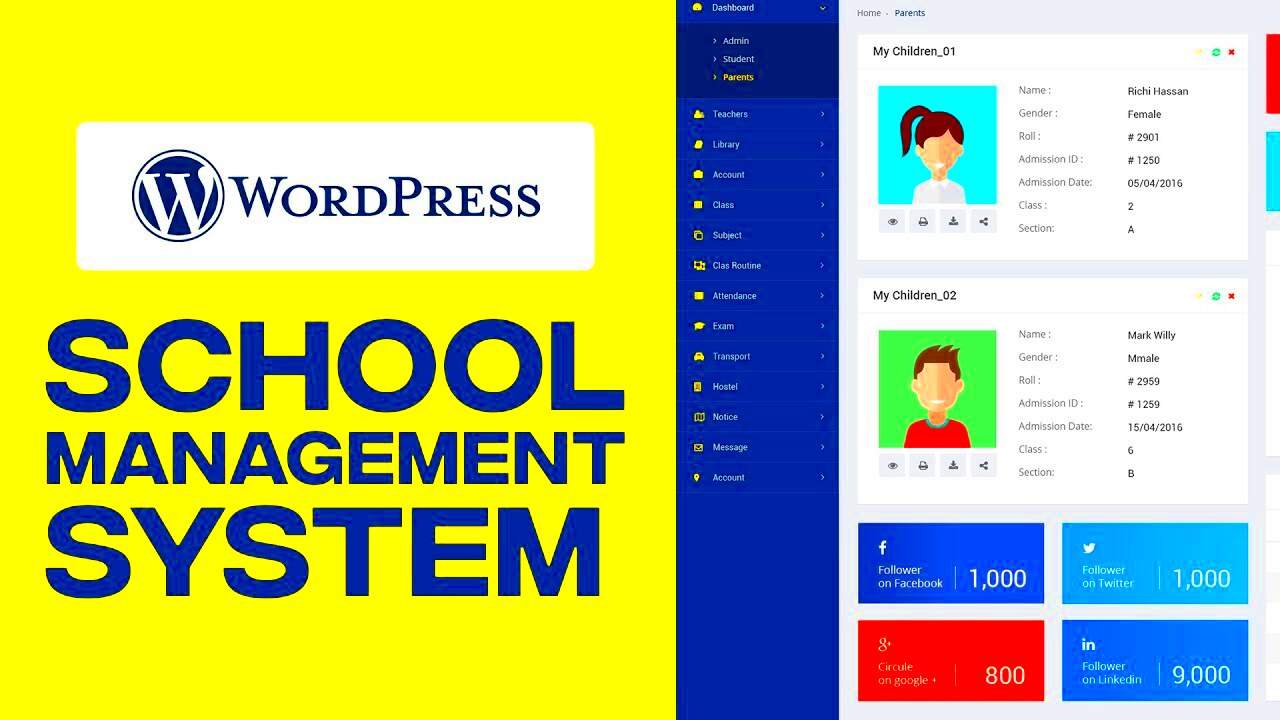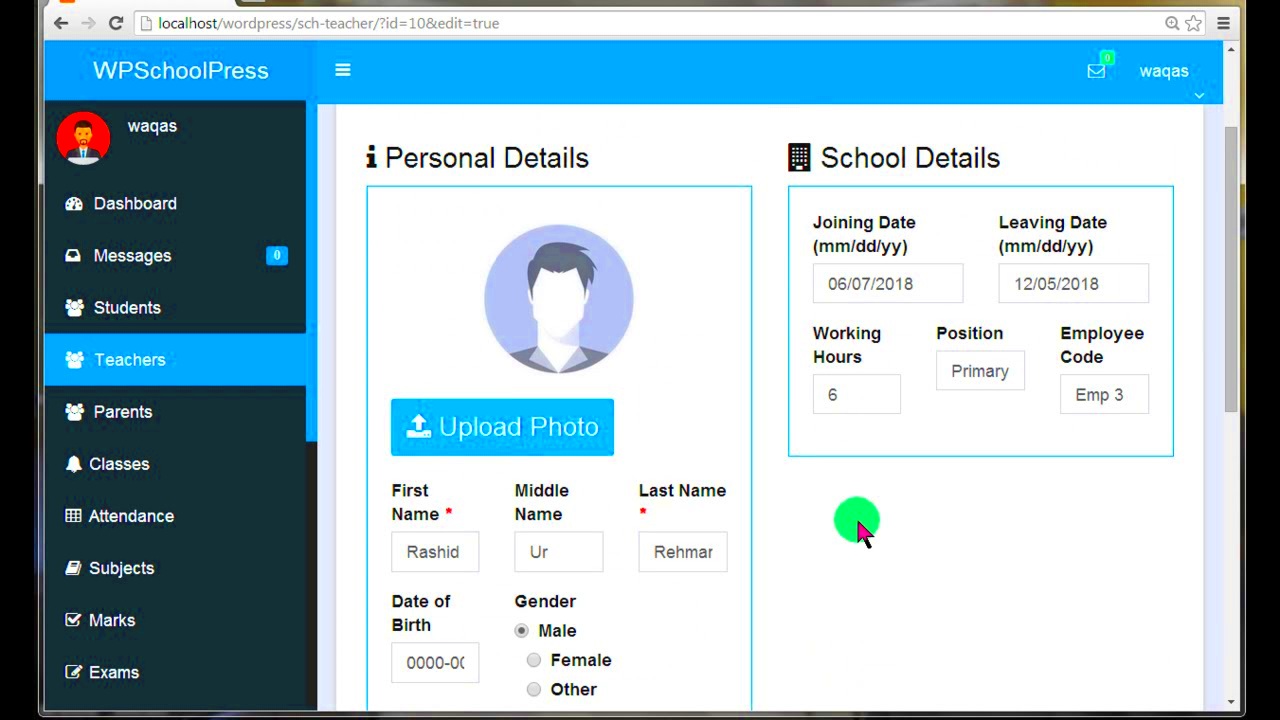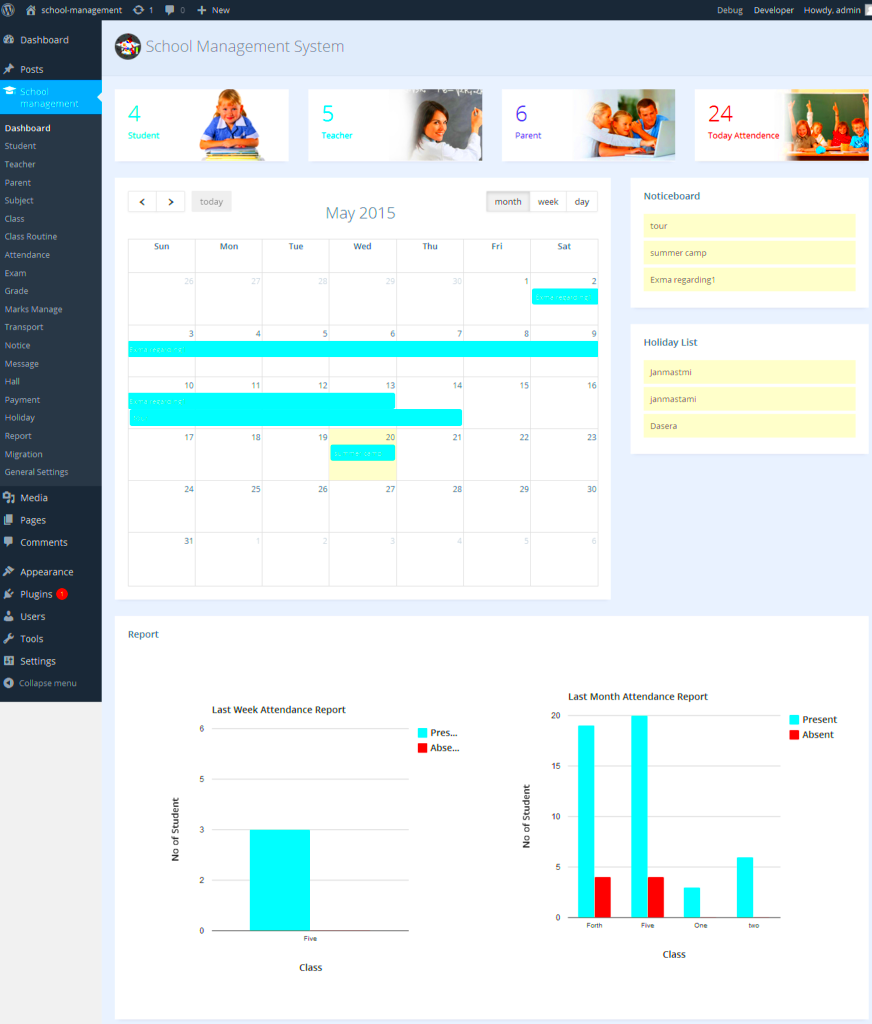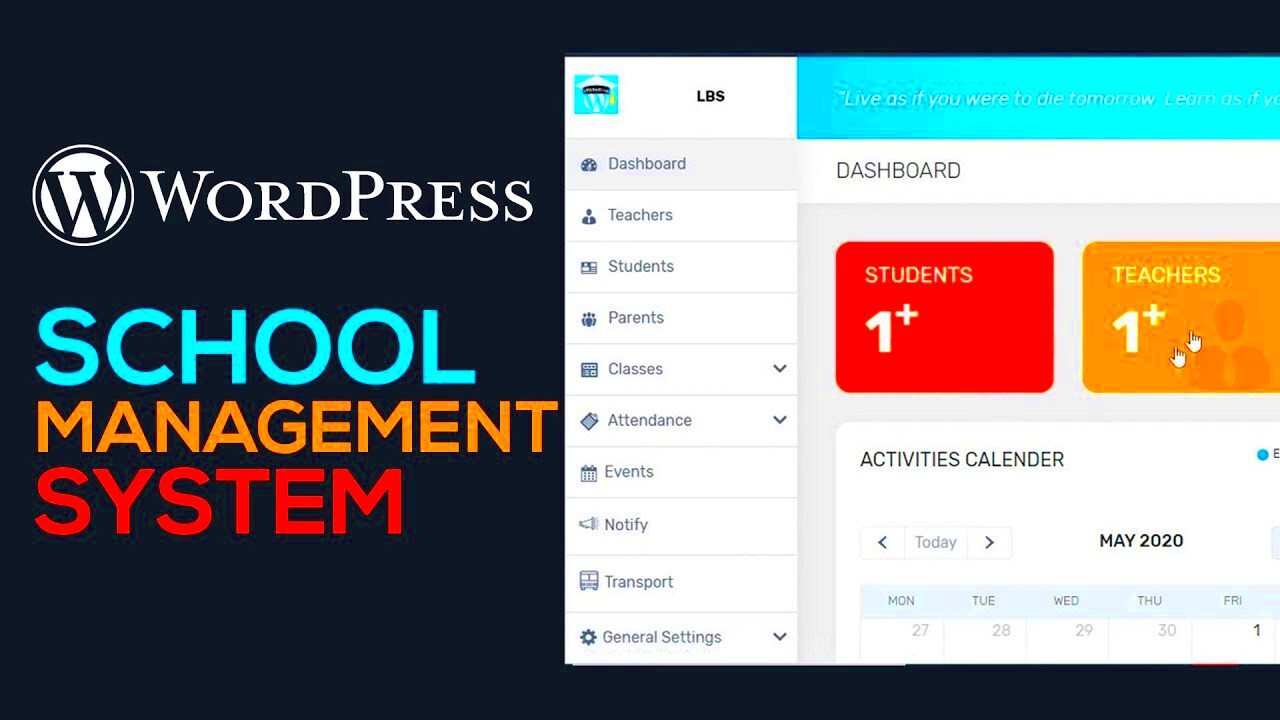School Management Systems (SMS) are software applications that help educational institutions streamline their operations. Whether you’re a small private school or a large district, SMS can revolutionize how you manage various administrative tasks. These systems encompass everything from student enrollment and attendance tracking to grade management and financial record keeping. As technology continues to evolve, schools are increasingly turning to digital solutions to enhance efficiency, improve communication, and provide a better educational experience for students and parents alike.
Benefits of Using WordPress for School Management

When it comes to setting up a School Management System, WordPress stands out as a robust and user-friendly platform. Here are some compelling reasons why WordPress is an excellent choice for school management:
- Easy to Use: WordPress has a very intuitive interface, making it simple for teachers and administrators to navigate without needing technical skills.
- Customizable Themes: There are numerous themes specifically tailored for educational institutions. You can easily find one that matches your school’s branding and needs.
- Plugins for Functionality: WordPress offers a plethora of plugins, which means you can extend the functionality of your school management system. From enrollment forms to attendance tracking, the possibilities are endless.
- Cost-Effective: WordPress is mostly free to use, and when paired with affordable hosting services, you can set up a budget-friendly solution for your school.
- Community Support: Being one of the largest platforms globally, WordPress boasts a vibrant community that offers extensive forums, guides, and resources.
In conclusion, choosing WordPress for your school management system not only simplifies administrative tasks but also enhances communication and engagement within the school community. It’s a decision that can lead to a more organized and efficient educational environment.
Key Features of School Management Systems

When it comes to managing a school, the right School Management System (SMS) can make a world of difference. Below are some of the key features you should look for when creating or evaluating a school management system with WordPress:
- Student Enrollment Management: This feature allows schools to streamline the registration process. It should offer online enrollment forms and automatic notifications for admissions.
- Course and Curriculum Management: You should be able to manage courses, assign teachers, and keep track of the curriculum easily. This can include adding course descriptions, schedules, and prerequisites.
- Grade Management: A system that helps teachers enter grades and manage report cards efficiently contributes significantly to academic tracking.
- Attendance Tracking: Taking attendance online simplifies the process and makes it easier to generate reports. Instant stats on student presence can alert you to any patterns of absenteeism.
- Parent and Student Portals: Providing portals for both students and parents can foster better communication. These portals can offer access to grades, attendance reports, and important announcements.
- Communication Tools: Built-in messaging systems can improve communication between teachers, students, and parents. This could include SMS, email, or notifications through the app.
- Financial Management: Keeping track of tuition payments, fees, and financial records is a necessity for smooth school operations.
- Reports and Analytics: The ability to generate reports on various aspects such as student performance, attendance and financials helps educators make informed decisions.
In summary, a school management system with these features not only simplifies day-to-day operations but also enhances the overall educational experience.
Choosing the Right Plugins for Your School Management System

Selecting the right plugins is crucial in setting up a school management system on WordPress. With so many options available, it can be overwhelming. Here’s a straightforward guide to help you make the best choices:
- Identify Your Needs: Determine the specific requirements of your school. Do you need extensive reporting capabilities, or is student registration your primary focus? This understanding will help you narrow down your options.
- Compatibility: Ensure the plugins you choose are compatible with your existing WordPress theme and other plugins. Incompatible plugins can cause conflicts and functionality issues.
- User Reviews and Ratings: Before committing, take the time to read user reviews. Better-rated plugins are typically more reliable and offer better customer support.
- Functionality: Look for plugins that offer a comprehensive set of features, such as calendar integration for events, grading systems, and communication tools.
- Support and Updates: Consider whether the plugin receives regular updates and offers technical support. Active support means you can resolve issues quickly when they arise.
- Cost: Analyze the cost versus the features provided. Some plugins may offer premium features that significantly enhance capabilities, while others may be more budget-friendly.
To help centralize your choices, here’s a simple table comparing some popular plugins:
| Plugin Name | Key Features | Price |
|---|---|---|
| WP School | Course management, attendance tracking | Free / Paid Options |
| WPLMS | Learning management system, mobile app | Paid |
| School Management System | Grade management, parent portals | Free / Paid Options |
In conclusion, the selection of plugins for your WordPress-based school management system can greatly enhance how your institution operates. By carefully considering your needs and available options, you’re well on your way to creating an effective system.
Step-by-Step Guide to Setting Up a School Management System with WordPress
Setting up a school management system using WordPress can feel like a daunting task, but it’s more straightforward than you might think! Let’s break it down into manageable steps.
- Choose a Reliable Hosting Provider: Start by selecting a good hosting provider that supports WordPress installations. Look for features like easy WordPress integration, reliable uptime, and customer support. Popular choices are Bluehost, SiteGround, and WP Engine.
- Install WordPress: Most hosting providers offer a one-click installation for WordPress. Follow the prompts to install it on your chosen domain name.
- Select a School Management Theme: Browse the WordPress theme repository or platforms like ThemeForest to find a school management theme that suits your needs. Look for features like responsiveness, clean design, and compatibility with plugins.
- Install Essential Plugins: Some plugins to consider include:
- LearnDash: For course management and tracking.
- WPForms: To create custom forms for registrations and inquiries.
- MemberPress: For membership management.
With careful planning and attention to detail, your school management system can be up and running in no time!
Customizing Your School Management System
Now that you’ve set up your school management system, let’s talk about customization. Personalizing your platform will help it reflect your school’s identity and meet your community’s needs. Here’s how to get started!
- Personalize Your Theme: Most themes come with customization options. Access the WordPress Customizer to change colors, fonts, and layouts to align with your school’s branding. Consider adding your logo and school colors to create a cohesive look.
- Add Functionalities with Plugins: Depending on your specific needs, you might want additional functionalities. For example, adding plugins for:
- SEO: Use Yoast SEO to optimize your website for search engines.
- Analytics: Integrate Google Analytics to track user engagement and traffic.
- Security: Install security plugins like Wordfence for enhanced protection.
Customizing your school management system not only enhances its appearance but also improves usability and ensures that it serves your academic community in the best possible way!
Best Practices for Maintaining Your School Management System
Alright, let’s dive into the nitty-gritty of keeping your School Management System (SMS) running smoothly! Maintaining your SMS is crucial for ensuring that it performs well, stays secure, and meets the evolving needs of your educational institution. Here are some best practices that can help you keep everything in check.
- Regular Backups: Always have a backup plan! Set up automated backups of your database and files at regular intervals. This way, if something goes wrong, you can easily restore your system without losing valuable data.
- Keep WordPress Updated: Ensure that your WordPress installation, themes, and plugins are up-to-date. Updates often include security patches and new features that improve system performance. Running outdated software can lead to vulnerabilities.
- Monitor User Access: Regularly review user accounts and permissions. Only give access to those who need it and make adjustments when staff changes occur. This helps in ensuring that sensitive information is secure.
- Optimize Performance: Speed is key! Optimize your database, use caching plugins, and consider a Content Delivery Network (CDN) to enhance loading times. A slow system can frustrate users and reduce engagement.
- Conduct Regular Audits: Periodically run audits to assess the effectiveness and usage of the system. Gather feedback from users to identify areas for improvement and functionality that may be lacking.
- Implement Security Measures: Use strong passwords, enable two-factor authentication, and consider security plugins to protect your site from breaches. Cybersecurity is often overlooked but is essential for protecting student and staff information.
By following these best practices, you can ensure that your School Management System stays efficient and reliable, letting you focus more on education and less on technical glitches!
Conclusion: Enhancing Education with WordPress
In conclusion, WordPress is a powerful platform that can significantly enhance the way schools manage their administrative tasks. By leveraging a School Management System built on WordPress, educators can streamline processes, improve communication, and foster collaboration among students, teachers, and parents.
Here’s why integrating WordPress into your educational environment makes sense:
- User-Friendly: WordPress is intuitive, making it easy for teachers and administrators to navigate without extensive technical training.
- Cost-Effective: With numerous free and premium plugins, schools can create a fully functional SMS without breaking the bank.
- Customizable: From themes to plugins, WordPress offers endless customization options. Schools can tailor their systems to meet specific needs and branding.
- Scalability: As your school grows, your SMS can grow with it. Whether you’re adding new features or expanding user access, WordPress handles scaling seamlessly.
- Strong Community Support: With a large user base, finding help or resources for troubleshooting and development is easier than ever.
In today’s digital age, enhancing education is all about harnessing technology. By adopting a School Management System powered by WordPress, you’re not just streamlining administrative tasks; you’re also paving the way for a more engaged, collaborative, and effective learning environment. Here’s to a brighter future in education!



